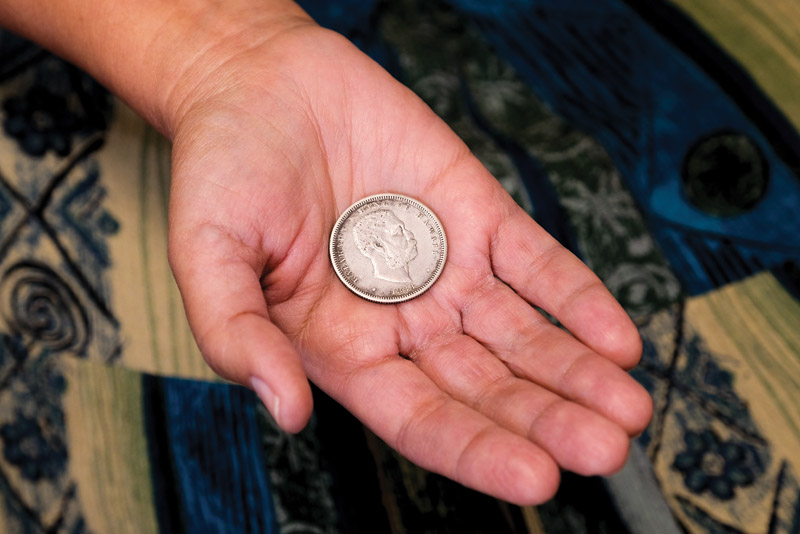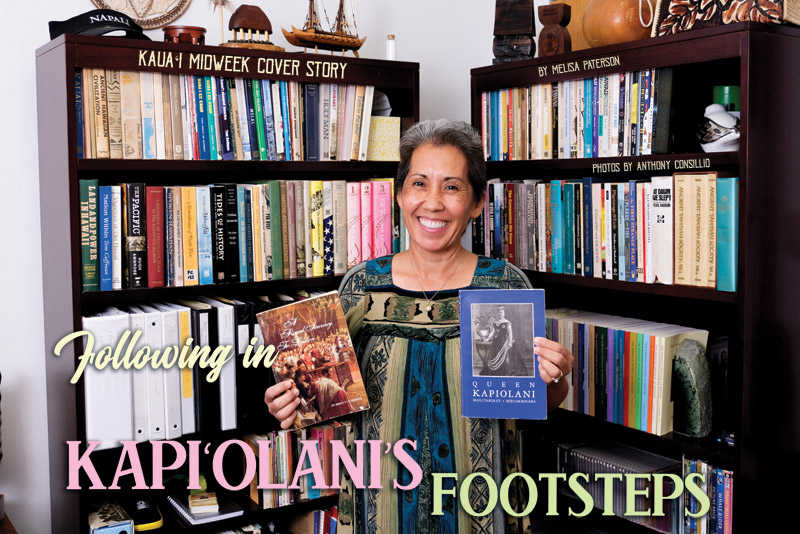Following In Kapiolani’s Footsteps
COLETTE HIGGINS HAS QUITE LITERALLY TRAVELED THE PATH OF QUEEN KAPIʻOLANI AND SHARES WITH ALL WHO WILL LISTEN THE MONARCHʼS LEGACY AND TIES TO THE GARDEN ISLE.
As dean of academic affairs at Windward Community College on O‘ahu, Colette Higgins continues a lifelong journey, following her love of history and education wherever it may lead her, including to the Garden Isle, where she shares her knowledge of the iconic matriarch with locals.
Over the past year, Higgins’ journey has brought her to Kaua‘i for a set of lectures on the life of Queen Kapi‘olani. One presentation was through Kaua‘i Community College and UH Foundation’s Alumni Relations and another at All Saints’ Episcopal Church in Kapa‘a on the anniversary of Queen Kapi‘olani’s death.
Kaua‘i Museum executive director Chucky Boy Chock was in attendance at Higgins’
Kaua‘i lecture, and is more than impressed with her knowledge.
“Colette’s work was not only important but truly remarkable, as if you were on this journey with Queen Kapi‘olani,” he says.
Many people, Chock adds, might still be unfamiliar with the life of Queen Kapi‘olani and her familial ties to the Garden Island.
“Kapi‘olani Napelakapuokaka‘e was born in 1834 in Hilo to high chief Kūhiō Kalaniana‘ole and high chiefess Kinoiki Kekaulike of Kaua‘i, daughter of King Kaumuali‘i, last ali‘i aimoku of Kaua‘i and Ni‘ihau,” Chock explains. “She was beloved by all throughout Hawai‘i.”
Higgins shares a similar connection to Kaua‘i.
“Of the 32 presentations I’ve done to date, the Kaua‘i Community College audience was by far the best — so gracious, kind and attentive. They really seemed drawn to Queen Kapi‘olani’s story.

Colette Higgins holds her Kalakaua hapalua (half dollar), which was minted at the Old Mint in San Francisco.
“I don’t know when I’ll return to Kaua‘i, but I am open to doing future presentations. I love Kaua‘i. My husband and I spent our honeymoon there in 1990 at the old Coco Palms, so it holds a special place in my heart.”
The presentation that captivated Kaua‘i audiences was based on a monumental voyage that Higgins undertook in 2016. After spending over a decade researching the life of the monarch, Higgins decided to literally follow in the footsteps of Queen Kapi‘olani.
“I think it’s important to know about those who came before us,” she says. “I love it when I can connect the past to the present and show people that studying history is relevant to our times.”
For Higgins, past and present merged in 2002, when she was a Hawaiian history teacher at Kapi‘olani Community College. She was asked to lecture on Queen Kapi‘olani as part of an academic presentation.
“I was fascinated by the fact that there was so little written about her,” Higgins explains. “She served as queen for 17 years, the entire time her husband David Kalākaua was king, yet no one had done in-depth research on her. I wanted to know more about her personality and her interests.”
Higgins’ research culminated in 2016 when she embarked on a monumental voyage, choosing to travel, at times literally, “in the footsteps of Queen Kapi‘olani.”
Nearly 130 years earlier, in 1887, Queen Kapi‘olani made the long trek from Hawai‘i to London to attend Queen Victoria’s golden jubilee celebrations.
“I was intrigued by the length and complexity of the journey, and the places that she chose to visit along the way,” Higgins says. “I was curious to know what she may have experienced, to see if I could replicate some of that for myself. Like the queen, I was middleaged on this journey (I was 49, she was 52) and had not been to Boston, New York or London.
“Also, I had never been on a long-distance train ride or on a cruise ship, so these would be new experiences for me as they were for her. It was a great sabbatical project to combine my desire to travel while doing additional research on Queen Kapi‘olani.”
What Higgins discovered along the way was a queen with a remarkable love for the keiki and, perhaps, the first inspiration for what is now known as Kapi‘olani Medical Center for Women & Children.
“It was on this journey at Blackwell Island (now called Roosevelt Island) in New York that (Queen Kapi‘olani) observed a very modern maternity ward at a charity hospital,” Higgins continues. “I believe that visit inspired her to open the Kapi‘olani Maternity Home, which is her legacy.
“The queen loved children. I found numerous newspaper articles written by reporters who were observing her behavior and describing what they saw. She seemed to go out of her way to pay attention to the children.”
According to Higgins, Queen Kapi‘olani didn’t raise any children of her own. She says the queen had a stillborn child with her first husband, Bennet Namakeha. She then served as the wet nurse to Prince Albert (son of Kamehameha IV and Queen Emma), who died when he was only 4 years old. She had no children with her second husband, Kalākaua.
After her sister Kekaulike died in 1884, she became the guardian to her three sons (David Kawānanakoa, Jonah Kūhiō Kalaniana‘ole and Edward Keali‘iahonui).
“I think when she builds the maternity home, part of her inspiration is personal, she knows what it is like to lose a baby and a little child,” says Higgins. “This woman who loved children had no children of her own, but she found a way to utilize her motherly skills.
“Her enduring legacy is Kapi‘olani Medical Center for Women & Children, which she established as a maternity home in 1890, three years after her journey. I think she’d be pleased that they still focus on women and children.”
Higgins believes that the journey of Queen Kapi‘olani holds a greater lesson for all.
“She used her travel experience to learn about how other societies addressed specific issues, and sought to bring that knowledge back home to make improvements in Hawai‘i,” says Higgins. “Her life, and her 1887 journey in particular, demonstrates that she was both proud to be Hawaiian and willing to learn from others beyond our shores. We don’t have to choose only one way, we can do both.”
For Higgins, while she loves her current role at Windward CC, the administrative position has left no time to further her research into the life of Queen Kapi‘olani.
“I’m too busy being a dean,” she laughs. “I think I need to retire before I can write a decent book.”
For more information, find Higgins online at inthefootstepsofkapiolani.wordpress.com.





